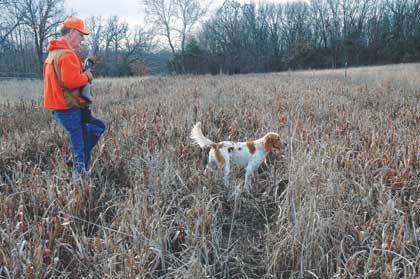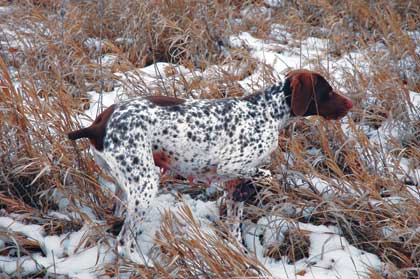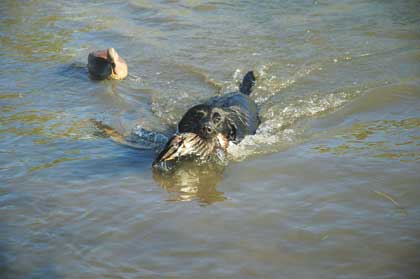By Chad Mason
 This setter's tail would contribute very little to his visibility on point, being only inches higher than his head. |
Gun dog enthusiasts carry on arguments about various canine attributes, almost reaching sufficient vocal pitch to make you think the arguments are important. We loudly debate the relative merits of pointers versus flushers, white dogs versus dark, small dogs versus large. One such argument that often generates much heat (if little light) is the one about long-tailed dogs versus bob-tailed dogs. How much utility does a tail provide, from a bird hunter's perspective?
If you think for a moment that I'm going to solve this argument right here, then you are obviously prone to overestimating both my intellect and my influence. Although such a tendency qualifies you as an ideal hunting partner for me, I must burst your bubble in the interest of truthfulness. The argument will go on after this. What follows is (hopefully) a contribution to the argument, not an end of it.
To put things in proper perspective, I quote Steven Mulak, a gun dog writer of the first rank, whose elegant and modestly titled little book, How to Hunt with a Pointing Dog, is worth reading by gun dog enthusiasts of all types. In that wonderful collection of essays, Mulak gave the following, helpful definition of a dog: "A dog is a life-support system for a nose."
In other words, the business end of the dog is located at the other end of the animal than that which presently concerns us. This fact should warn us that we are debating a subject of only minor importance. We shouldn't let the tail wag the dog.
Nevertheless, it is worth our time to consider how a tail contributes to (or detracts from) a dog's function in the field and home. Let's talk about the field first.
Over the past 30 years — wow, that number keeps growing really fast — I've been blessed to share the woods and waters with six bob-tailed breeds and six long-tailed breeds. These have included representatives of the pure pointing breeds (4), spaniels (2), retrievers (2), and 'continental' or versatile breeds (4). Incidentally, I am considering the Brittany a versatile breed, not a pure pointer.
I note, with more than passing curiosity, that tail length divides almost precisely along those categories. All of the retriever breeds have full-length tails, as do all of the pure pointing breeds, while the spaniels and versatile breeds are mostly bob-tailed, or at least have their tails reduced. What does this teach us?
Well, it may be nothing more than a reflection of regional tastes. Perhaps German practicality abhors a tail, while the English penchant for gratuitous beauty demands one. There may be some truth to this theory, but it falls short in the end (pun intended), since the spaniels are quintessentially English.
Of course, with the possible exception of griffon owners, nobody likes an ugly dog. (Oh boy, here comes the mail.) Maybe the tails are docked on some breeds because they do not develop aesthetically pleasing tails. In that case, it is beauty and not practicality that demands cutting, since a bobtail is better than an ugly tail. I've seen only one Brittany and a couple of springer spaniels whose tails had never been cut, and they looked pretty scruffy. But this theory, too, will get us only so far. Once I saw a German shorthair with a full-length tail, and that dog looked pretty decent.
 This bob-tailed Braque Francais wouldn't be any prettier — or more visible — on point with a longer tail. |
In order to explain tail-bobbing customs, perhaps we should talk about functionality. The function of a retriever's tail should be self-evident to anyone who has watched one swim. Retriever fans inevitably explain that the tail acts as a rudder, a steering device, or a sweeping paddle that helps the dog pivot nimbly while afloat. But I think a tail's utility in the water goes well beyond steering.
My Labrador Woody's tail undulates behind him as he swims, and I've come to believe that he uses it to assist in propulsion, like an alligator. In order for a tail to be so useful, it must be the right kind of tail. Woody's tail is thick, long, and densely furred. A slender, rope-like tail would not be nearly so useful.
A tail is not necessary for a swimming dog, but it is undeniably advantageous. In the days before Woody came into our home, Rascal, my English cocker with barely half a tail, once retrieved eight geese from a large pond in one morning. He chased a cripple 60 yards across that pond, and finally got it when it came up from its third dive.
Rascal is by no means an expert waterfowl hunter; he's just a stubborn old geezer who would walk through Hell in a kerosene suit to get a bird in his mouth. So, sans tail, he set his face and grunted his way through a job that Woody could now do in half as much time. Leg length has a lot to do with the difference, but I think the tail helps, too.
On dry ground, the usefulness of a tail becomes more ambiguous. You will sometimes hear a story, from a pointing dog owner, about a time when the dog went on point and the dog's tail was the only visible thing on the dog. This happens, no doubt, but it happens rarely because several circumstances must coincide.
If the dog's head is low or darkly colored, and if the grass is just high enough to obscure the dog's body but not his tail, and if the tip of the dog's tail contrasts with the landscape, and if the dog holds his tail higher than the rest of his body, then the tail will be our only tip-off that the dog has pointed. Look at the accompanying photo of a typical setter on point, however, and you'll see that the dog's tail normally extends only a few inches above his head. Consequently, I doubt visibility accounts for long tails in pointing dogs. Customs usually emerge from pressing daily needs, and not from rare occurrences.
I've heard some hunters — especially among the "field-bred" spaniel crowd — say that an uncut tail makes it easier to tell when a dog is "making game." They say it's easier to tell when the dog is "birdy" if his tail is long. After hunting with lots of bobtailed dogs, including some "show-bred" spaniels that were pretty good hunters, I find this claim unbelievable.
In my judgment, a long tail can make it more difficult for some hunters to discern when the dog is making game, because the tail's flowing movement while running can fool our eyes. By contrast, a bobbed tail
does not flow or swirl when the dog runs. The rapid vibration of a bobbed tail says, as unmistakably as any body language can say, "There's a bird here somewhere!"
 Woody puts his big tail to good use, retrieving a wood duck for the author. |
We should not overemphasize either the merits or demerits of tail length. I believe a tail, whether long or short, is of very little practical consequence, either good or bad, when hunting birds on dry ground. And it's not even a deal-breaker in the water. Mulak is right; the other end of the dog is much more important.
In the home, there can be little doubt that a full-length tail is no advantage. Having shared a home with Woody for two years now, I can testify that a long tail works well for the efficient and untimely clearing of coffee tables. Moreover, patience is needed to ensure that the whole dog has entered the house before you close the door behind him. Most perilous of all, a happy dog's tail, when thumped against a metal kitchen garbage can, will wake a sleeping wife in any part of the house. Thus can a tail jeopardize the safety of both dog and handler.
Ultimately, I suppose the origins and purposes of tail cutting will remain obscure, and so the argument will continue. That's good. What else would we talk about?






